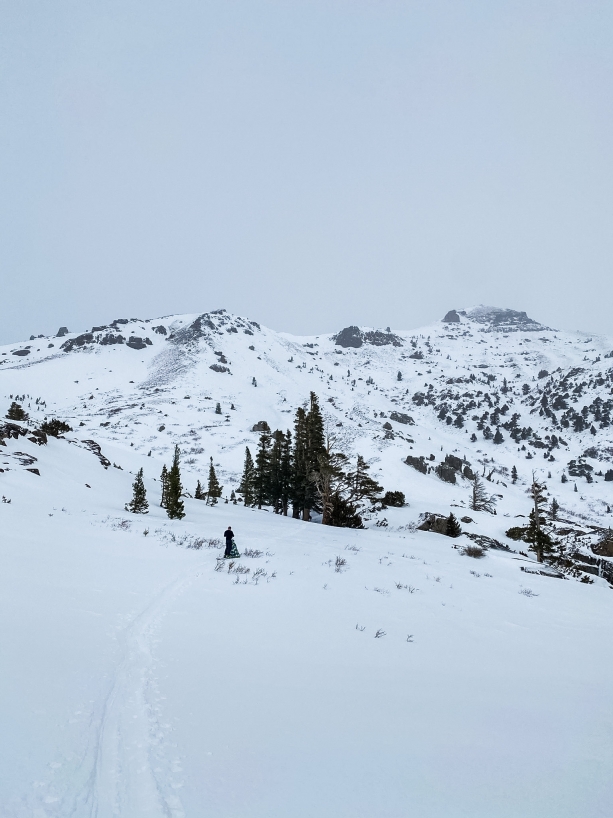
So what is this backcountry thing everyone’s talking about?
Backcountry skiing and snowboarding is basically riding anywhere that is not a patrolled ski resort. I like to think of it as hiking but then you get to ride down at the end, which is way better than just hiking down.
This intro post is the first in a series of Backcountry 101 posts that’s going to give you the scoop on what backcountry skiing and snowboarding is, the gear, safety precautions, and how to get out there and have some fun. So stay tuned in the coming weeks for more backcountry goodness!

Types of Backcountry Skiing and Snowboarding
Side-country/Slack country: This is when you start out at a resort, take a lift up, and then leave the resort through a designated gate. When I say designated gate I mean an actual gate that tells you that you are leaving the ski resort, don’t just duck ropes, it’s not cool and you’ll get your pass pulled. Once you go out that gate you are no longer in the ski resort and therefore no longer in a patrolled or avalanche controlled area. You’re not in the resort but you’re still close to civilization. This is how a lot of people get into backcountry riding since it’s pretty accessible. Going out a gate at Heavenly was my first taste of backcountry-ing.
Touring/Backcountry: No lifts, no lines, just you and the mountain. This is when you head out on a trail up a mountain and have to hike or skin your way to the top. This also means that there is no ski patrol or anyone to help you if you wind up in a sticky situation. It generally requires a bit more preparation to mitigate those risks, you need to have maps and routes figured out as well as snowpack and avalanche knowledge. But when you do it right you can have an epic day!

Risks
I’m not going to sugarcoat this at all, the backcountry can be risky business and not the Tom Cruise dancing in your underpants kind. There are real, life-threatening risks to backcountry skiing and snowboarding which include, avalanche, injury, inclement weather, and difficult terrain. I don’t want to make this sound like some extreme sports disaster movie (The Vertical Limit, anyone?), but these risks need to be taken seriously. However, there are ways to reduce your risk and have a great time in the backcountry. Simple things like checking the weather and not going out when it’s bad, checking the avalanche report for current avalanche and snowpack conditions, planning your routes in accordance with the safest snowpack and avalanche threat, and taking an avy course.

Why??
Why do people do this? Because it’s fun, because it’s a challenge, why do people do anything? The main reasons are to get those untracked lines and fresh snow all to yourself, to escape the crowds of the resorts, and to ride something new. It’s an adventure.

Gear
So is this a whole new sport with all new gear? Ehh, well yes and no. If you are trying some side country out of the ski resort you can generally use the regular downhill gear you’ve got. You might have to unbuckle to do some boot packing but it’s not the end of the world. But to actually get yourself up a mountain you are going to need some specialty gear.
Splitboard: A splitboard is a snowboard that splits in two and becomes skis for your uphill journey. You also will require specialty bindings for your splitboard that allow you your heel to come up as you hike, but then can transition to traditional snowboard bindings for the ride downhill.
Alpine Touring Skis: These backcountry skis have specialty bindings that allow you to walk uphill, a lot like cross-country skis. But then you are able to tighten everything down like traditional skis for the downhill.
Skins: Funny little carpets you put on the bottom of your skis or split apart splitboard for going uphill. The fibers go in one direction so you don’t slide backward.
Avy Gear: The essential avy gear you’ll need are a beacon to get an idea of where a person is buried, a probe for poking through the snow to find the exact spot a person is, and a shovel for digging them out.

I hope this has given you a good idea of what backcountry skiing and snowboarding is. Stay tuned in the coming weeks for more in-depth posts about gear, safety, and training!
Clothes for warmth and sun protection
READ MORE:
Backcountry 101: Gear
Backcountry 101: Safety
Backcountry 101: Training
Like this post? Pin it!





Pingback: Backcountry 101: Gear - Nattie on the Road
Pingback: Backcountry 101: Safety - Nattie on the Road
Pingback: Backcountry 101: Training - Nattie on the Road